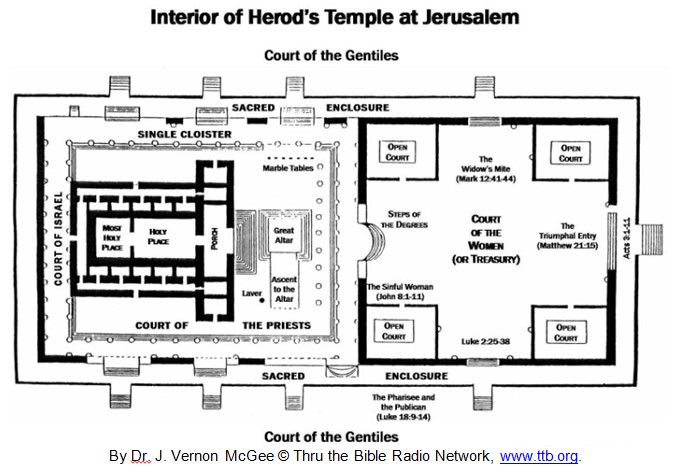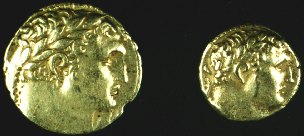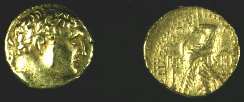Read John 2:12-25
12 After this he went down to Capernaum with his mother and brothers and his disciples. There they stayed for a few days.
13 When it was almost time for the Jewish Passover, Jesus went up to Jerusalem. 14 In the temple courts he found people selling cattle, sheep and doves, and others sitting at tables exchanging money. 15 So he made a whip out of cords, and drove all from the temple courts, both sheep and cattle; he scattered the coins of the money changers and overturned their tables. 16 To those who sold doves he said, “Get these out of here! Stop turning my Father’s house into a market!” 17 His disciples remembered that it is written: “Zeal for your house will consume me.”
18 The Jews then responded to him, “What sign can you show us to prove your authority to do all this?”
19 Jesus answered them, “Destroy this temple, and I will raise it again in three days.”
20 They replied, “It has taken forty-six years to build this temple, and you are going to raise it in three days?” 21 But the temple he had spoken of was his body. 22 After he was raised from the dead, his disciples recalled what he had said. Then they believed the scripture and the words that Jesus had spoken.
23 Now while he was in Jerusalem at the Passover Festival, many people saw the signs he was performing and believed in his name. 24 But Jesus would not entrust himself to them, for he knew all people. 25 He did not need any testimony about mankind, for he knew what was in each person.
Because John chose to describe this episode here, some people say that there must have been two similar occasions when Jesus did this. But we have already seen that John was not writing a diary: he simply recounted events as he needed them, to explain or reinforce the message that he was writing.
Before we get into the main story we have verse 12: After this he went down to Capernaum with his mother and brothers and his disciples. There they stayed for a few days.
Why did John say this? Why did they not simply return to Nazareth? Where was Jesus’ father?
We can only guess. Capernaum was a lakeside village, twenty miles to the north-west of Nazareth – perhaps they had a holiday! It is assumed that Jesus’ father was older than Mary and as this was thirty years after Jesus’ birth, he may well have died by now. If so, the family would have needed the income that Jesus’ brothers could provide but we know nothing more of them.
Peter, Andrew, James and John all came from Capernaum. Perhaps they too had offered a home to Jesus' family.
Read John 2:13
13 When it was almost time for the Jewish Passover, Jesus went up to Jerusalem.
Why did John choose to insert this narrative here?
Most likely it is because he wished to continue the theme he had started concerning the hypocrisy of the whole ‘Oral Torah’ system as it was applied by the ‘Scribes, Pharisees and Teachers of the Law’. And this was at its height when considering the whole system of Temple Worship, especially at a time of festival – and there was no greater festival than Passover. There would have possibly been hundreds of thousands of people in Jerusalem for the Passover, having travelled from all over the land of Israel and beyond.
God had given strict rules for the Passover (Exodus 12:1-28, 43-49, Leviticus 23:5-8), but many interpretations and extra rules had been added to that. Besides that, many chapters in the Old Testament contained God’s instructions concerning the Tabernacle and worship. Here again was a great opportunity for more rules and interpretations.
But here particularly would be seen the worst excesses of the religious system that had developed. And if we agree that the ‘Cleansing of the Temple’ described here only happened once, then it was this Passover which would culminate with the offering of God’s sinless lamb as saviour of the world, thus opening up a whole new way for man to get right with God.
Read John 2:14
14 In the temple courts he found people selling cattle, sheep and doves

The rules stated that in order to enter the inner courtyard you should be ceremonially clean, so you would have carried out the necessary ablutions.
But then you might well be aware of sin in your life for which an offering
should be made – a bull, or perhaps a pair of doves. Only then might you be considered ready to take part in the main festival of Passover, which would require the purchase of a lamb.
Of course all these animals had to be without spot or blemish, and the priests guaranteed that any sold within the court of the Gentiles would be fully acceptable. This would have needed a vast number of animals, but many animals that had been given to the priests as an offering would simply be returned to their own traders for re-sale. That was quite acceptable as not all the animals that were offered had to be consumed as burnt sacrifices, the Law stated that they became the property of the Priests (Deuteronomy 18:1, 14:22-29).
Then there was the requirement to pay the Half-Shekel 'Temple Tax' - (originally atonement money - Exodus 30:13. But this was only acceptable using accredited currency:
and others sitting at tables exchanging money. The money-changers may well have been priests, as only they had access to the store of Temple half-shekel coins.
The following is taken from http://www.begedivri.com/shekel/J-Tyrian.htm
A Lesson in Priorities
 In the second century BC, Rome, the ruling power, operated two mints in the Mediterranean region, one in Lebanon at Tyre, and the second at Antioch. The mint in Tyre produced Tyrian Shekels and Half-Shekels, of a 95% silver purity. In the year 19 BC Rome closed the mint in Tyre and began to import an inferior silver coinage from the Far East consisting of 80% pure silver.
In the second century BC, Rome, the ruling power, operated two mints in the Mediterranean region, one in Lebanon at Tyre, and the second at Antioch. The mint in Tyre produced Tyrian Shekels and Half-Shekels, of a 95% silver purity. In the year 19 BC Rome closed the mint in Tyre and began to import an inferior silver coinage from the Far East consisting of 80% pure silver.
The Religious leaders in Israel, realizing that the new coinage was not sufficiently pure to fulfil the Commandment of giving the Holy Half-Shekel, appealed to the Emperor for permission to produce a ceremonial coin of sufficient purity to fulfil the religious obligations. The Rabbanim received special dispensation to produce the requisite coinage on condition that they continue with the motif of the Tyrian Shekel, so as not to arouse objections within the Roman Empire that the Jews were granted "autonomy" to mint their own coinage.
 Now the Rabbanim in the year 19/18 BCE had a serious problem. On the one hand, the giving of the Holy Half-Shekel is a Torah Commandment. The problem arises with the motif of the Tyrian Shekel. On the obverse appears the image of Melkhart, known to us as Hercules, the god of the Phoenicians. On the reverse, appears an eagle on the bow of a ship with the legend: "Tyre the Holy and City of Refuge", and the date of issue.
Now the Rabbanim in the year 19/18 BCE had a serious problem. On the one hand, the giving of the Holy Half-Shekel is a Torah Commandment. The problem arises with the motif of the Tyrian Shekel. On the obverse appears the image of Melkhart, known to us as Hercules, the god of the Phoenicians. On the reverse, appears an eagle on the bow of a ship with the legend: "Tyre the Holy and City of Refuge", and the date of issue.
Both images, a foreign god (or any likeness of man) and an eagle, are Torah prohibitions. And yet the Rabbanim decided that the importance of the giving of the Holy Half-Shekel superseded the violations incurred in using the Tyrian motif.
This showed the difficulty that the Oral Torah presented, with conflicting rules which had to be reconciled. It also explains why money-changers were necessary. The Temple treasurers maintained a stock of pure half-shekel coins and these would be made available to the money changers who charged a standard fee for providing their service. Once these coins had been used in payment, they had to be taken out of the treasury and again resold.
When these practices were established, they were intended solely to help visitors to the Temple in their worship. However by the time of Jesus, a major festival like Passover had become at best a ‘trading opportunity’ and at worst a chance to ‘rip off the tourists’. The Temple Courts themselves had taken on the appearance of a busy, noisy bazaar – not the hushed, Holy Temple envisaged by Solomon where 'only blocks dressed at the quarry were used, and no hammer, chisel or any other iron tool was heard at the temple site while it was being built' (1 Kings 6:7).
Mark 11:17 And as he taught them, he said, ‘Is it not written: “My house will be called a house of prayer for all nations”? But you have made it “a den of robbers”(Quoting Isaiah 56:7 and Jeremiah 7:11).
This then was the scene which met Jesus and his disciples as they entered the Temple courts.
Read John 2:15-17
15 So he made a whip out of cords, and drove all from the temple courts, both sheep and cattle; he scattered the coins of the money changers and overturned their tables. 16 To those who sold doves he said, “Get these out of here! Stop turning my Father’s house into a market!” 17 His disciples remembered that it is written: “Zeal for your house will consume me.”
The noise of the market would have meant that if Jesus had shouted, he would not have been heard. So he made a whip – not to attack the people with, but to crack above their heads. (The fine strands at the end of a whip actually move faster than the speed of sound, breaking the sound barrier, and creating a mini sonic boom! Using several strings increases the sound. As a young boy I enjoyed making and playing with just such a whip – I can guarantee the sound is startling!)
Animals respond automatically to a man with a whip, and once a stampede had started, they would all have willingly followed.
To suggest that Jesus was zealous to see the Temple restored to the holy sanctuary that it had been designed for, was an understatement. Here was a furious man, obviously full of authority and power, and you didn’t stop to argue with him.
But of course those who claimed to have authority in the Temple saw their source of income disrupted:
Read John 2:18
18 The Jews then responded to him, “What sign can you show us to prove your authority to do all this?”
Who were 'The Jews'?
This term, used many times in this Gospel, generally refers to the Scribes (legal experts), Pharisees (ultra-zealous law-makers and law keepers – a powerful minority group), Sadducees (members of the rich and powerful aristocracy - priestly families and wealthy merchants) and Elders (tribal and family heads).
It was from these that was drawn the Sanhedrin, the ruling Jewish council.
So ingrained was the Rabbinic system, that if a new Rabbi came, teaching and demonstrating new insights into the interpretation of their laws, the first response would be to listen to his teaching, to see if he was authentic.
After three years of ministry, Jesus the Miracle Worker would already be known to the authorities. They had heard his teaching but they had not understood it, or who he was. What they did know was that he worked miracles, so they demanded that he give them a sign to demonstrate his authority.
Read John 2:19-20
19 Jesus answered them, “Destroy this temple, and I will raise it again in three days.”
20 They replied, “It has taken forty-six years to build this temple, and you are going to raise it in three days?”
Could Jesus, the creator of the universe have literally done that?
Of course he could.
But this put his antagonists in an impossible position. They had challenged him to perform a miracle. Jesus offered to do something truly miraculous but of course they could not take up his offer as it would mean destroying the Temple. What no-one realised was that they would that week do exactly that, and Jesus would rebuild it! (For the timing of this episode see study: Easter)
Read John 2:21-25
21 But the temple he had spoken of was his body. 22 After he was raised from the dead, his disciples recalled what he had said. Then they believed the scripture and the words that Jesus had spoken.
23 Now while he was in Jerusalem at the Passover Festival, many people saw the signs he was performing and believed in his name. 24 But Jesus would not entrust himself to them, for he knew all people. 25 He did not need any testimony about mankind, for he knew what was in each person.
As ever, there were people who had come to the Passover with great needs and in his compassion he provided miraculous relief. How and what he did, we are not told. But just as in the case of Nathanael, he knew the heart of each individual. And he knew that the people were not to be trusted – the crowds that had welcomed him with hosannas yesterday (Matthew 21:1-11) would be the same who four days later would shout ‘Crucify him, crucify him’ (Luke 23:18- 25)


 In the second century BC, Rome, the ruling power, operated two mints in the Mediterranean region, one in Lebanon at Tyre, and the second at Antioch. The mint in Tyre produced Tyrian Shekels and Half-Shekels, of a 95% silver purity. In the year 19 BC Rome closed the mint in Tyre and began to import an inferior silver coinage from the Far East consisting of 80% pure silver.
In the second century BC, Rome, the ruling power, operated two mints in the Mediterranean region, one in Lebanon at Tyre, and the second at Antioch. The mint in Tyre produced Tyrian Shekels and Half-Shekels, of a 95% silver purity. In the year 19 BC Rome closed the mint in Tyre and began to import an inferior silver coinage from the Far East consisting of 80% pure silver. Now the Rabbanim in the year 19/18 BCE had a serious problem. On the one hand, the giving of the Holy Half-Shekel is a Torah Commandment. The problem arises with the motif of the Tyrian Shekel. On the obverse appears the image of Melkhart, known to us as Hercules, the god of the Phoenicians. On the reverse, appears an eagle on the bow of a ship with the legend: "Tyre the Holy and City of Refuge", and the date of issue.
Now the Rabbanim in the year 19/18 BCE had a serious problem. On the one hand, the giving of the Holy Half-Shekel is a Torah Commandment. The problem arises with the motif of the Tyrian Shekel. On the obverse appears the image of Melkhart, known to us as Hercules, the god of the Phoenicians. On the reverse, appears an eagle on the bow of a ship with the legend: "Tyre the Holy and City of Refuge", and the date of issue.

